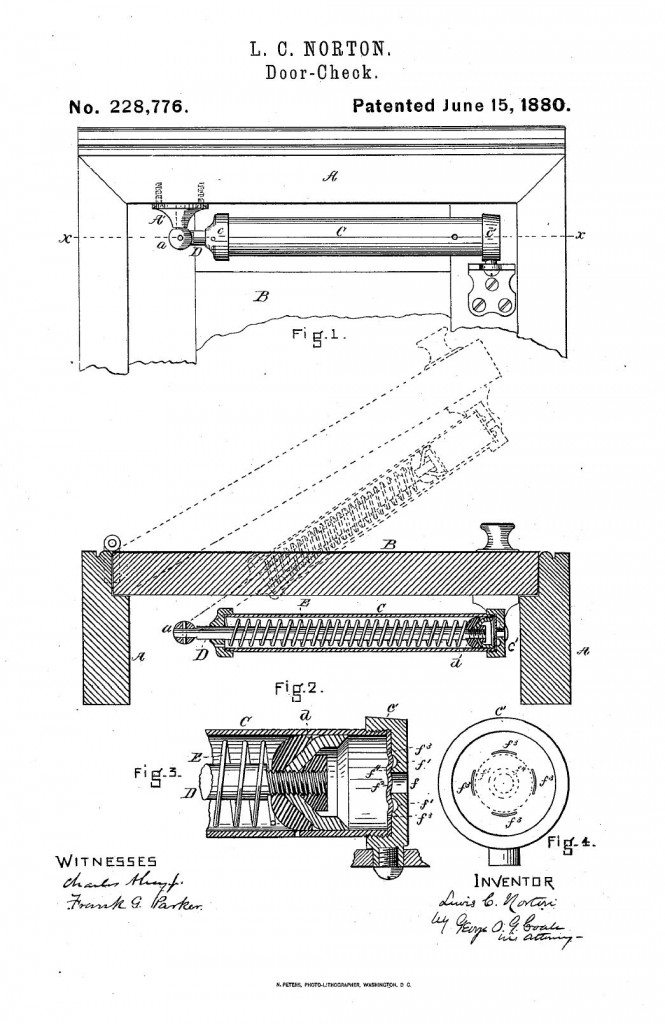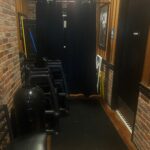I posted Part 1 of this article a while back, and apparently there have been people waiting patiently for the second installment. As requested, here is Part 2. Part 3 to follow.
A Memoir from 1880 – How I Discovered Door Checks
by L.C. Norton, Inventor of Door Checks
After inventing the door check, I started a business to sell it. Then my real troubles began.
_______________________________________________________
In the June 1986 issue of Doors and Hardware, Norton described how he invented the door check. In this segment of the door check story he describes his struggles in setting up a company which would make and sell a quality product.
Norton was asked to compile this history by his partner, D.R. Lasier. The company finally founded in 1926 came to be known as LCN Closers in 1948. The manuscript was uncovered recently when someone at LCN headquarters in Princeton, IL, was looking through old records stored in an unused desk.
_______________________________________________________
“There remains a fortune to the man who can invent a door that cannot be left open and cannot be slammed.”
I thought it a little strange that I should see that item in the Boston Transcript newspaper, just as I was working on that very thing, so I went down to see the manager and tell him what I had. He laughed at me and said he had seen such fools before. I told him, all right, but I would like to put one of my fixtures on his outside door. After telling me it had never been done and he knew I could not do it, he finally said, “Go ahead and let’s see how smart you are.” So the next morning I took a door check that was made for Trinity Church. I also took a man with me to hold the stepladder as the door was very high and people coming and going constantly. At that time I had no spring in connection with the check, as I used the spring hinges on the church doors. So I told the newspaper manager that he had a good spring on his door and I would use that to shut the door. He said, “Absolutely no.” I said, “All right, I would use my own.” I took his off and went to Wilkinson’s Hardware Store and bought two springs since the ones he had were not long enough. I fastened two together with wire and it worked all right.
Then, we went to work to install the door check. At that time we had no way to regulate the air except for a leather disc in the end of the cylinder with slots cut through it to allow just the right amount of air to pass. It did not take long to attach the check, but to regulate it was exceedingly difficult. We worked all day, with the manager behind the counter making fun of us. We gave it up when night came, only to renew it the next morning.
To change the regulation, we had to take the check apart, put in a new leather disc and cut the slot a little different and try it again. We kept this up until about noontime the second day and at last we got it and it worked what we called “perfect.” Then we called the manager and we had our fun. He was so taken with the device that he gave up his work and stopped everybody coming in to look at this wonderful device.
Starting a Business
Soon after this the Boston Herald and the Boston Journal had them put on their doors. This attracted so much attention among the merchants downtown, that a Mr. Doolittle, president of a wholesale drug company in Boston, called on me and wanted to form a company to manufacture and sell the article in the United States.
His proposition seemed pretty good to me as he agreed to form a company of $200,000 and have $35,000 working capital, allowing me $5,000 in cash and one-quarter of the capital stock. I accepted his proposition and the company was formed in Portland, Maine, called The Norton Door Check and Spring Company.
As soon as the company was formed, I severed my connection with the Trinity Church and turned my work over to my friend, a Mr. Chester. He remained in the care of Trinity Church until he died.
We located our factory at 477 Tremont Street and commenced building door checks. It was only a few days after we were located that I met the manager of the Boston Transcript and he wanted to buy the patent. His idea was to sell state rights, and he said he could easily guarantee me $200,000. I told him that that would be just fine, but that he was just a few days too late – the company contract was signed and the matter was settled. He seemed very much hurt about it. He gave me a little advice, he said “Well, Norton, you will now lock yourself up in some machine shop and there you will spend the rest of your life.” He hit it about right.
We had hardly started in the little factory before the orders came rolling in. To start with, we only had an engine, lathe, a few drills, a grinder and a large Fox lathe that could do everything but talk. With this equipment we could turn out some fifty checks per day. We kept this up for a year or more.
During this time we had an exhibit in the Massachusetts Charitable Mechanics Association, Fair Building, Boston, in 1881 and we were awarded first prize and a gold medal.
At this fair we took an order for four dozen door checks to go to Australia, and another to fit up a Senators’ Club House in Washington, D.C.
The list price on these door checks was No. 1…$6.00, No. 2…$5.00, No. 3…$4.00.
Expanding the Company
Equipping the factory with new machinery and increasing our production called for additional money, and our president, Mr. Doolittle, who was a wholesale druggist, recommended to a friend of his in New York, a Mr. Ward of the firm of Lyon Mfg. Co. who were manufacturing druggist, that he take some stock in our Door Check Company. After looking into it carefully, he finally put in $10,000, which helped quite a bit.
Mr. Ward became very much interested in the door check, and believed he could sell the goods all over the world. Mr. Ward’s partners in London, the American Agencies Co. or Mr. Perie E. Richards also became very much interested, and we made the Lyon Mfg. Co., otherwise P.H. Drake & Co., our sole agents for the United States. This worked out very well, as they paid cash for all the goods they ordered, and their selling faculties were the best. Things went on smoothly for a while.
It seemed we were not to have the exclusive in the door check field. In 1882 a rival came up in a company by the name of Elliot Pneumatic Door Check Company of Nashua, NH, with a factory in Norwood, MA.
After they had gotten nicely under way, our patent attorney, Mr. George O. Cole, informed me they were infringing our patent, No. 228776. We promptly brought suit for infringement. Their sales were small, but the suit lasted three years and cost us a lot of money.
We won the suit, put them out of business and collected one barrel of old castings.
 In the meantime, we accumulated a stock of 2500 door checks, as the sales were not keeping up with the output of the factory. In consulting with Mr. Ward, he said he found difficulty in getting men who understood the door check, and asked if I would be willing to make a trip west to establish subagents. Now we had a young many by the name of John Sherman who was our bookkeeper, a mighty fine fellow and greatly interested in the business. In fact he would work all day in the factory and do his book-keeping nights.
In the meantime, we accumulated a stock of 2500 door checks, as the sales were not keeping up with the output of the factory. In consulting with Mr. Ward, he said he found difficulty in getting men who understood the door check, and asked if I would be willing to make a trip west to establish subagents. Now we had a young many by the name of John Sherman who was our bookkeeper, a mighty fine fellow and greatly interested in the business. In fact he would work all day in the factory and do his book-keeping nights.
I suggested to Mr. Ward that we both go, Mr. Sherman and I, as we could make better time by working together. So it was arranged that we go at once.
As soon as we got to Pittsburgh, we found places where we could demonstrate the door check. Mr. Sherman’s door was in a bank and mine in a store. Well, we both had our troubles. The check I was trying to put on was badly built. The arms were out of line and the friction prevented the check from closing the door. After working several hours fixing the door and latch, I found it was no use. The arms must be forged over. I found a forge in a dark basement and after an hour I had the trouble remedied and the door check worked fine.
But where was John? I went to find him and he was still working on the same door. Perspiration and soot were running down his face. His troubles were the same as mine, the arms not lined up. We soon fixed it and the day was gone.
We wondered if the 2500 checks in the factory were as bad as the ones we had. The first thing I did after returning to Boston was to set up a testing door to test every one of the 2500 door checks, so that no more poor ones would be shipped.
Personnel Problems and Solutions
While John and I were on the road, we wrote to Mr. Gillon, the foreman, not to ship any more goods out until they had been thoroughly tested. This evidently made him mad as he was responsible for the poor workmanship.
After setting up the testing machine, I went back to the office and while I was gone, Mr. Gillon knocked the testing machine to pieces and scattered it all over the floor. When I went out to see what was going on, he told me to get out of here as he was superintendent.
I promptly gave him his written discharge, called a special directors meeting and showed up the poor work, condemned such operations and the directors. Then I called a special stockholders meeting, put out the old board and put in a new board composed of men I knew at Trinity Church. Things went on smoothly for a while, but we needed a good man to take the place of Mr. Gillon.
The thought came to me that some of the large manufacturing concerns must have some good men. So, I went to the Walworth Manufacturing Company, whose business was steam heating, plumbing, etc. I told the manager I was looking for a mechanic who could act as foreman in our plant and did they have anyone they could recommend for that place. In fact, I would like to get the best man they had.
That was asking a good deal, I knew, but they were very nice about it. They said they had a man they would like to see get ahead, Mr. John Blount, who was a very good mechanic. The result was I engaged him at a salary of $5 per day, while the highest priced tool makers got $3.00.
To show what a hard thing it was to build a good door check that would meet the great variety of weather conditions, Mr. Blount said, after being with us two or three weeks, that building door checks was an easy job. In fact there was nothing to it. But, a while after he came into the office with something behind his back. He said, “Mr. Norton if you ask me to build a marine engine and make all the patterns, it would not trouble me a bit, but I’ll be darned if I know what is the matter with this little door check.” He had tried for three days to discover what was the trouble before coming to me.
The test was that when the check was set up it must hold the air for five minutes and this one went down in four minutes, and then in three minutes. “Well, John,” I said, “we must find the trouble. Take the check apart, and let’s have a look inside.” It showed some oil on the back of the piston. We wiped it dry and put it together again and made another test with the same results, four and three. “All right, take it apart again and let’s have a look.” Oil appeared on the back of the piston, same as before. “Well, John,” I said, “the trouble is the leather man who treated the leather. He made cup packing and has stuffed it with oil instead of tallow.” John took the check apart, soaked the leather in melted tallow and set it up again.
It held five minutes all right, and the next day it was still holding up the same. The pressure of air pushed the oil right through the pores of the leather, but the tallow held. Today we are just beginning to realize the value of tallow worked into our door check packing.
The 2500 checks in stock were taken down, the troubles corrected, re-assembled and ready to go out again.
Others Build the Product
By this time in 1881 and 1882, the door check was attracting a good deal of attention, especially among the hardware manufacturers, and we were bound to have more competition. In the same year, 1882, Mr. Ed Gillon and my brother-in-law, Mr. Walter Clark, got together and commenced to build what was called the Clark & Gillon check. It was built something after the style of ours, but infringing our patent, No. 228776. They lasted about a year, when they ran short of money and a suit for damages was brought and found in our favor. This put them out of business.
It was about this time or a little later in 1882 that the Sargent Hardware Company came out with a door check, of the air type, called the Sargent-Eclipse, or Plunger type. This was for checking the door only and the spring to close the door was a separate affair. The checking device carried in the plunger, a reinforcement to the cup leather packing, which infringed one of our patents, but it was of small account and we let it pass. This door check had quite a run, in fact, I guess some of them are still being made, now, in 1937.
A Shop Opens in Brooklyn.
It was somewhere about 1885 that the New York agency was not sending in all the orders we expected and we were running short of money, so the directors had to loan the company some to carry on. After awhile the directors were afraid they would lose what they had put in and called to have their notes paid. The directors were not businessmen and did not understand the situation very well.
The New York men were just getting very much interested in the business, and believed it would be a great success, so they came forward and took up the notes that were due. Soon afterwards they moved the factory to Brooklyn, New York, near where their patent medicine factory was. some of our men went to Brooklyn, but Mr. Blount, our fireman, and I did not go. Mr. Clark, one of Mr. Ward’s leading men was appointed superintendent and so for a few years the business was carried on with the door check company office in Boston.
The business was carried on this way till about the year 1887 when there was some disagreement between the agent, Mr. Ward, and the company. The agent held back from paying for the goods, until they owed the company some $22,000. It was about this time that a friend of mine, a Mr. Minard, who worked in the factory assembling the door checks and testing them, wrote me that if I had any interest in the company, I had better come on and look after it. The agents were planning to gobble up the whole business.
From this information and the fact that the agent owed the company $22,000 and would not pay, I called a directors meeting to see what could be done, and the minutes of the meeting were as follows:
Voted that it is expedient to have a new superintendent, Voted that Mr. Clark be removed and discharged from the office of superintendent, Voted that Mr. Lewis C. Norton be appointed superintendent with all of the authority of that office, and requested to proceed to Brooklyn forth-with and assume the duties of the office.
Therefore, I spent the larger part of each week at the works in the Brooklyn from November 8, 1887, until January 25, 1888.
Things were getting no better. Mr. Clark was very bitter against the company. There was no money being paid for the goods manufactured, and in January 1888 I reported to the board that some action would have to be taken which brought the final order as follows:
Voted that the superintendent be authorized to sell such parts of the property of the company now in Brooklyn or elsewhere in New York State as he thinks desirable and to bring all the rest to Boston.
Legal Troubles
This order caused me to proceed to Brooklyn prepared to bring the factory back to Boston. This was not a very easy job as the agents had already put on several attachments which must be raised before the machinery could be moved.
I planned accordingly. I found that Saturday after 1:00 p.m. was a holiday until Monday morning and no attachments could be put on after 1:00 p.m., so I took an attorney along with us and Mr. Sears, one of the directors also went along and cashed his check at a hotel, as the banks were closed on Saturday. This got us enough money to cover the cost of raising the attachments.
Some pretty quick work would have to be accomplished to take down the machinery and move it in half a day, while the attorney was busy raising the attachments. I went after some trucks to be ready at 1:00 p.m. to begin loading. I had six four-horse trucks waiting two blocks away, ready to appear on signal.
At 12:45 p.m. the attorney appeard, having raised all the attachments, and the fight was on. At 1:00 p.m. the factory doors were locked. Fifteen men armed with wrenches and bars were ready to take the machinery down. The first four-horse truck backed in and the finished door checks and rough material were loaded while the machinery was being taken down from the top two stories, ready to load. Soon after 1:00 p.m. Mr. Clark, the old superintendent, came and wanted to get in, but the doors were locked. Then he went to the man loading the trucks to know where the stuff was going, but no one knew, not even the drivers. But, when the truck was loaded, the driver was told to go to the Fall River Line Steamer and a man would meet him there.
The next truck loaded machinery, taking the heaviest pieces first, and in less time than it takes to tell, it was off to the New York and New Haven Freight. Mr. Clark was still trying to find out where it was all going. The next two trucks backed in and commenced loading whatever machinery and stock they could get the quickest. When these two trucks were ready to pull out, Mr. Ward’s attorneys came running up to stop any more stuff going out, but the two trucks had already cleared and were on their way to the Outside Line Steamship Co. This had cleared about nine-tenths of all the machinery and goods in the factory. The attorney had come in person as they knew I would not stop if they sent a clerk.
The attorneys told me Mr. Ward had agreed to pay the $22,000. They wanted to assure me that it was really so, so they had come themselves. My first thought was to ignore them and finish the job. Then I thought it might be better to get the money. So I gave in to them with the promise that the money would be forthcoming. then I went back to Boston to wait for developments.
After the last two trucks got away there was not very much left. I left Mr. Minard in charge with instructions to let me know if anything happened.
Well, true to their word, the agents paid up the $22,000. They also caused more attachments put on to the remaining fixtures. This caused me to go back the next Saturday, raise the attachments and finish the job.
This was not quite so easy. Mr. Clark was watching every move, even keeping tabs on the teamsters. But, like the previous Saturday, at 1:00 p.m. everything was cleared. Then the teams showed up from another direction. This time we didn’t leave a nail, and had everything away except the boiler and engine, which we had half way out of the basement when Mr. Clark came around and brought the cash for the engine and boiler if we would leave them. So we did.
This ended our dealings with the Lyon Manufacturing Co. or P.H. Drake & Co. or Wm. Ward. Hereafter all operations would be from Boston.
Part 3 of this article to follow. Reprinted with permission from Doors & Hardware.
Graphic of door check design: US Patent Office
Advertisement: Lori Greene Collection
Photos of Sears Building: Courtesy of New York Public Library
You need to login or register to bookmark/favorite this content.







Lori, I LOVE this!! cant wait for part 3:)
nicly made lori, i love this as well and me too, cant wait for part 3 to come out.
-Jess the door closer doctor
Lori, I have found this story very interesting. Thank you for sharing. Persistence pays!
In the piture above norton check door&spring I have one that looks the very same tring to find out some info on it and its value please help # 413 369 4026
I have just discovered one of these early door check and springs at my car repair garage, we have been a transport business since 1815 in UK, it’s amazing to find this piece of history. Must restore it, any ideas on colours? Great story too. ..Phill.
Hi Phill –
The one I have is dull brass – it doesn’t appear to have an applied finish on it. I’d love to see some photos of your discovery! lori.greene@allegion.com
– Lori